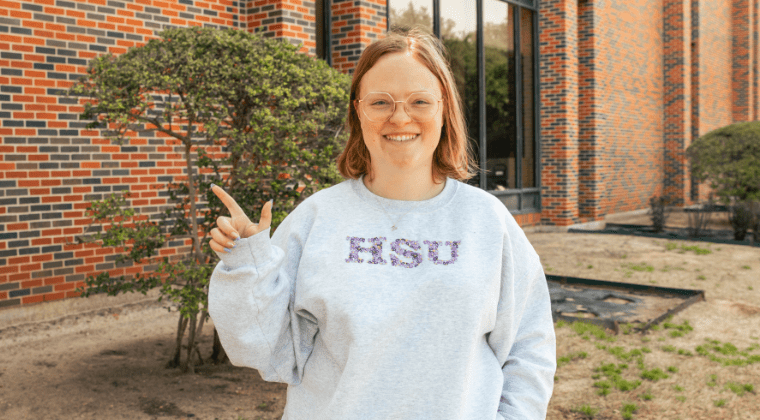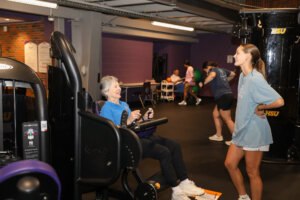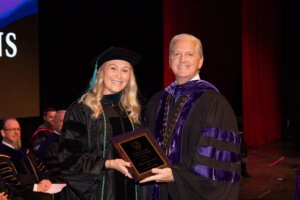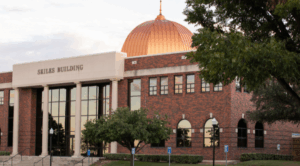Finding Her Voice and Helping Others Keep Theirs
How a Hardin-Simmons Student’s Parkinson’s Research Is Transforming Voice Therapy in Rural West Texas

Like many children, Marlee Sorrells, a student from Lindale, Texas, grew up hearing family stories: some funny, some heartwarming, and some that stuck with her. One in particular came from her mother, who often spoke about her best friend—Marlee’s great-grandfather—who lived with Parkinson’s disease.
“His diagnosis was a big deal in our family,” Marlee recalled. “I grew up hearing how the disease affected him.”
One vivid memory involved what’s known as non-inhibitory stepping, a symptom that can cause people to have difficulty stopping motor movement.
“My mom told me about this time they came home to find him running through a field because he physically couldn’t stop,” Marlee shared. “It really stuck with me.”
Now a senior in Hardin-Simmons University’s Communication Sciences and Disorders program, that early memory has turned into a full-fledged research project. As part of her Honors capstone, Marlee is exploring a powerful question: Can physical therapy help Parkinson’s patients do more than move? Can it help them speak more clearly, too?
The Research Project
Parkinson’s disease often weakens breath support, making it harder for individuals to speak at a normal volume. Their speech may become difficult to understand due to imprecise articulation and a rapid speech rate. When Marlee began exploring ideas for her capstone, her professor encouraged her to connect with a growing initiative on campus: a Parkinson’s-focused fitness group recently launched by the PT department and the university recreation center.
“Dr. Jill Jumper walked me through a few options,” Marlee said. “At first, we talked about doing something that was both educational and interactive for students within the College of Health Professions at HSU.”
However, Marlee eventually decided to work directly with individuals with Parkinson’s disease. She designed a survey-based study that allows participants to self-report how they perceive changes in their voice since starting to exercise regularly under the guidance of a physical therapist.
“We asked, what if physical therapy—just exercise and movement—could indirectly improve voice by strengthening the pulmonary system?” she explained. “There’s already solid research showing that regular exercise helps improve breathing in runners and athletes. So maybe, just maybe, we could see similar benefits for people with Parkinson’s.”
Her goal is to find out whether voice outcomes can improve through physical therapy alone, without the use of traditional speech therapy.
To gather data, Marlee distributed surveys to members of the local HSU Parkinson’s fitness group, which includes about 30 participants ranging in age from their 50s to 80s. The subjects’ length of time since diagnosis ranged from two months to over 15 years. The surveys ask participants to rate voice elements like volume, pitch, and articulation, as well as how they perceive their own level of disability.
“Participants are also assessing how they view their own disability,” Marlee said. “One of the final questions on my survey asks, ‘Has your view on Parkinson’s changed since starting PT?’ And for the most part, the answer has been yes. Many participants have noticed their tremors improving, and some have even said they have been able to reduce their medication that helps manage their symptoms caused by Parkinson’s.”
Contributing to Rural West Texas

Hardin-Simmons University students volunteer to help local Parkinson’s patients at the Fletcher Fitness Center on campus.
Her research also contributes to a broader campus effort to expand interdisciplinary care in West Texas. The university’s speech-language pathology program is preparing to launch the SPEAK OUT!® Therapy Program, developed by Parkinson Voice Project®, which helps people with Parkinson’s and related neurological disorders regain and retain their speech and swallowing. Eventually, the goal is to offer both physical therapy and speech therapy services through the university’s clinic.
In a region where only one Lee Silverman Voice Treatment (LSVT)-certified speech therapist is available within a 50-mile radius, Marlee hopes her work highlights how collaborative, community-based programs can help bridge the gap in care for individuals with Parkinson’s in rural West Texas.
“My hope is that this research will show that there are many secondary benefits of participation in community support groups and that exercising under the guidance of a physical therapist can improve not only motor functions, but also respiratory support needed for adequate vocal volume,” said Marlee.
The role of therapists is vital in the long-term care of individuals with degenerative neuromuscular disorders like Parkinson’s disease.
“Not everyone has access to a movement disorder specialist,” said Marlee. “Individuals from this area often travel several hours just to see one, but therapists are everywhere. If therapists can work collaboratively with each other and with the patients’ physician, it can make a big difference in a person’s life.”
Marlee will present her research in early May and hopes to use it as a starting point for graduate school in the fall.
“I’ll be starting graduate school in speech-language pathology at Texas Tech in the fall, which is super exciting,” Marlee shared. “They have a neurogenic lab I’m hoping to work in, so if that works out, I’ll have the chance to take this research to a much larger scale.”


